Welcome to Elounda
Elounda, Crete
Once a simple fishing village, in recent years the community of Elounda in eastern Crete has become a lively, cosmopolitan destination for visitors from around the world.
Its local population of about 2,000 includes a scattering of isolated settlements in the hills above the sparkling Gulf of Mirabello, whilst the main village of Schisma, known as central Elounda, perches charmingly on the coast next to the picturesque harbour and between a selection of Blue Flag beaches.
In recent years, Elounda has evolved into a fully-fledged resort, and is said to be the place with the most five-star hotels in Greece.
Despite large visitor numbers and numerous hotel blocks, the community itself has retained much of its charm, and offers day-trippers a range of sights, including the setting for a popular TV show, an island leper colony, and even a sunken city – possibly the original Atlantis!
From Georgioupolis, follow the well-maintained National Road 165 km eastward along the north coast to Agios Nikolaos, and then turn left to Elounda just before entering the main town. Enjoy beautiful views of the coastline and the serene Mirabello Bay on this stretch of road. You can expect the entire journey to take at least 2 ½ hours.
In central Elounda, you will find free parking close to the main beach, just north of the small fishing harbour. You can now choose to park here and explore the town on foot, or take a drive out onto the Spinalonga Peninsula.
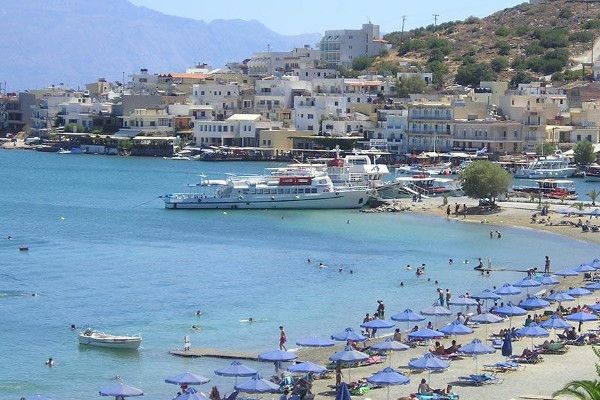
Elounda Main Beach
The town’s main beach is just north of the carpark and well-organized, with sun loungers, parasols and a lifeguard. The sea here is suitable for water sports and there is a children’s play area close by.
Elounda Harbour
Just south of the main beach, Elounda harbour is cloistered by a beautiful, natural lagoon known as the Gulf of Korfos, with the rugged Spinalonga Peninsula forming a natural barrier to the east and Spinalonga Island guarding its northern neck.
Here in the sparkling blue waters of the gulf, many fishing boats and excursion vessels bob around colourfully in the small fishing port. Boat trips to the Island of Spinalonga run approx. every 30 minutes from here in summer, transporting you to the haunting and ghostly remains of a former leper colony – a far cry from the cosmopolitan bustle of Elounda.
Elounda Main Square
Overlooking the quayside, the palm-fringed main square, Pl. Elountas, is a bustling, cosmopolitan hub with many bars, restaurants and kafenia, but you need only delve a few streets deeper inland to uncover the local flavour and more traditional watering holes.
Walking back through the square, follow Akti Olountos street leading south-east along the waterside. It takes you past a string of colourful bars and restaurants offering traditional fare and harbour views. After about 200 metres, you will come to the Ferryman taverna, recognisable from the 1977 BBC TV series, ‘Who Pays the Ferryman?’. Fans will remember the secret stairway, smothered in oleander, and the familiar mosaics. The proprietor is also happy to share evocative photographs from the past and the taverna’s history as a film set with visitors.
After the taverna, you can continue your tour on foot, taking one of the flights of stairs up to the right onto the main road, or return to your car so that you can explore more of the Spinalonga Peninsula.
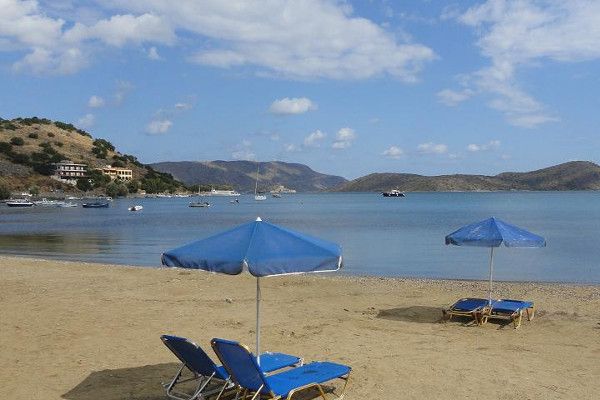
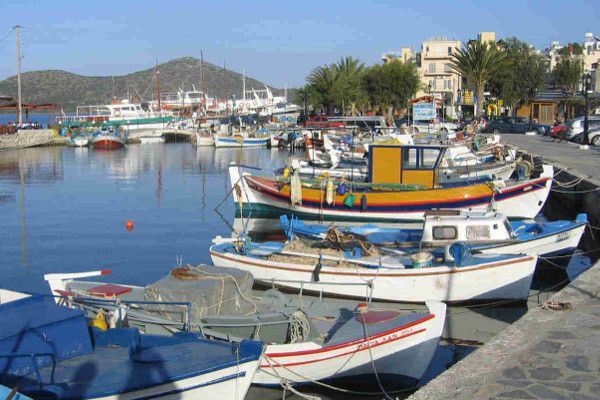
Venetian Saltpans
Take the main road, Agiou Nikolaou-Vrouchas, and continue to follow it south-east until the road forks. Take a left and re-join Akti Olountos street down along the waterside.
Continue on, passing the smaller, east beach of Elounda, and you will find yourself on a narrow strip of land, a causeway with sparkling sea water to your left and right. If you look carefully on your right-hand side, you will discern stone walls forming large squares. These are the Venetian saltpans, a valuable commodity for Venetian trading vessels from the 13th century onwards. The seawater evaporated inside these squares, leaving behind the precious salt crystals, which could then be collected and stored.
The Sunken City of Olous
At the end of the tarmac road, you will see a picturesque stone bridge across a small canal, built by the French in 1897 to facilitate trade. In ancient times, this was the site of the powerful city-state of Olous, one of the important Dorian cities of ancient Crete, with more than 30,000 inhabitants. Ancient texts have linked the city to the Palace of Knossos and the island of Rhodes. You can view the treaty between Olous and Rhodes in the Museum of Agios Nikolaos.
Today, if you want to view the remains of this once mighty city, you will need to cast your gaze downwards through the crystal-clear waters at your feet. On a calm day in the shallow sea, you will be able to make out the remains of ancient wall bases and the rubble of long-lost streets from the road. Along the causeway, some of the city’s ancient walls peek out above the waves.
Built on soft, coastal sands, the city was presumably struck by a major earthquake, and movements of the sea floor caused Olous to slip down under the waters it once presided over. Now it lies at the bottom of Poros Bay.
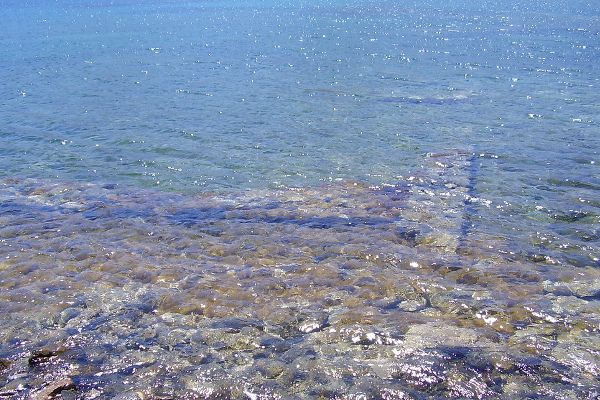
Historic Remains
The historic sights above the waves are just as interesting to admire. Two deserted windmill towers loom over the desolate, wild landscape of the Spinalonga Peninsula and make for a lovely photo motif against the dazzling Mirabello Bay.
Just across the isthmus, at the base of the Spinalonga Peninsula, a brown sign marks the significant remains of the Early Christian Basilica of Poros, dating back to the 5th century. Its extraordinary floor mosaic with depictions of fish, birds and floral motifs within a geometric framework has been well-preserved and is open to the public for viewing.
If you have your car, you can continue along the dirt road onto the peninsula itself. 200-300 m along, take a right onto a track that cuts across the peninsula. After 3-4 minutes, the road leads to the small chapel of Saint Luke. You can park here, and enjoy panoramic views of the coastline and Kolokytha Island, a nesting site for thousands of seabirds.
On foot, follow one of the downhill trails from the chapel to a lovely secluded cove with white sand and sparkling calm waters, closeted by olive groves. This is Kolokytha beach, a popular bathing spot. The beach becomes busy in the afternoon with the arrival of numerous tour boats. Aim to visit before 12 noon, or later in the evening, to enjoy a more tranquil experience.
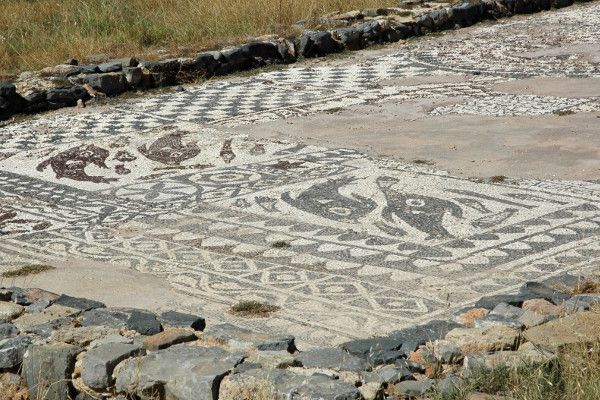
Spinalonga Island
Returning to Elounda along the causeway, this may be the time to stop by one of the beautifully positioned tavernas, and sit on the terrace with a refreshing drink.
Revitalised, it’s time to pay a visit to the dominant feature on the skyline – the island of Spinalonga.
From 1903 until 1957, Spinalonga was a leper colony, where sufferers were sent under quarantine to live out their lives apart from civilisation. Separated by just a narrow water channel, hundreds of lepers led a parallel existence here, marooned from friends and family, yet creating their own version of “normality” through gardening, theatre, and even running their own newspaper and cinema.
One of the last active leper colonies in Europe, it was only in July 1957, after two world wars and the development of antileprosy drugs, that the last remaining sufferers were transferred to a hospital near Athens. Vestiges of their lives still cling to the ghostly, empty streets they left behind. A visit to their derelict homes, with traces of their personal belongings, is certain to make an impression.
Boat trips to the island leave from Elounda harbour. In the high season, the island can receive up to 2,000 visitors a day, but there are still plenty of local boat owners who are more than happy to take you across to the island once the tour groups are finished for the day, so that you can experience the island’s haunting ambience in stillness.

Discover heavenly Crete for yourself
An island full of surprises
A holiday destination for bathing enthusiasts, nature lovers, hikers, and those interested in history and culture. Today, Crete is one of the most popular tourist destinations in the Mediterranean - cosmopolitan yet mysterious.
Popular hotels on the sandy beach
The Corissia Hotels are situated within the tranquil, picturesque village of Georgioupolis right on the sandy beach. An ideal seaside resort both to relax and explore the island, because that is just what holidays on Crete are all about.
Let yourself be pampered
 OUR BEST
OUR BEST